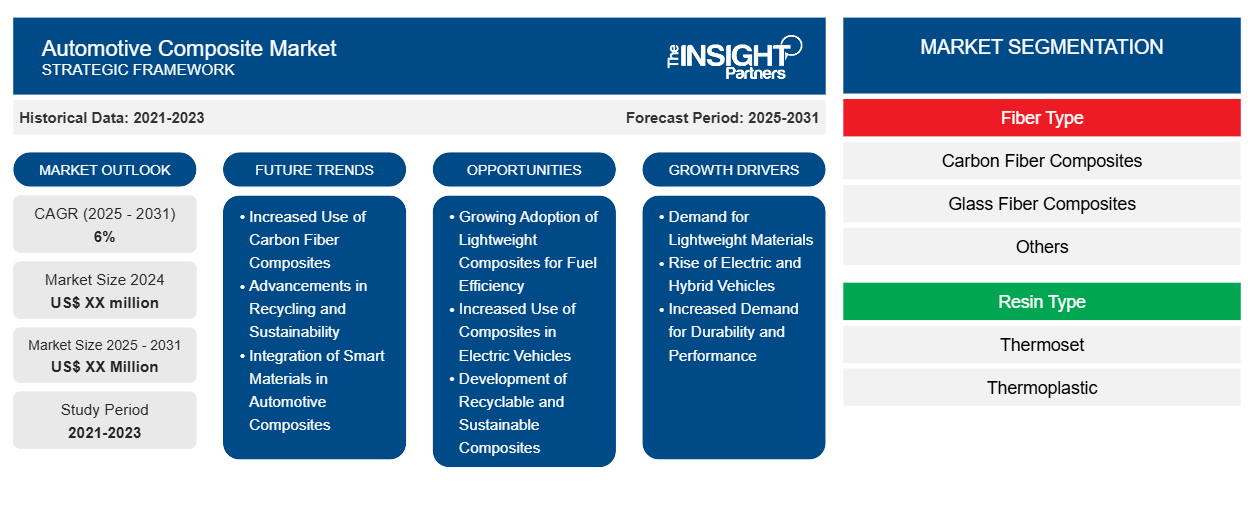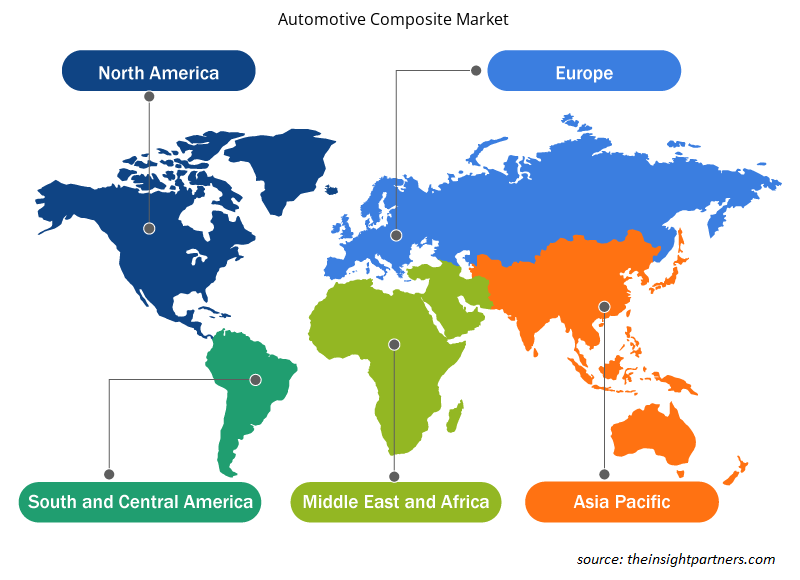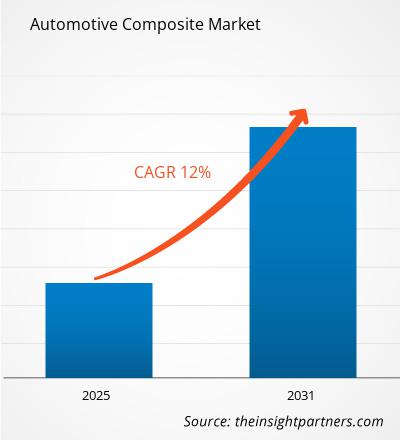The automotive composites market is expected to reach US$ 28.30 billion by 2031 from US$ 13.00 billion in 2024. The market is estimated to register a CAGR of 12.0% during the forecast period.
The report is segmented by Fiber Type (Carbon Fiber Composites, Glass Fiber Composites, and Others). The report further presents analysis based on, Resin Type [Thermoset (Polyester, Vinyl Ester, Epoxy, Polyurethane, and Others), Thermoplastic (Polypropylene, Polyethylene, Polyvinylchloride, Polystyrene, Polyethylene Terephthalate, Polycarbonate, and Others)]. Based on Based on Vehicle Type report is segmented into (Passenger Vehicles, Light Commercial Vehicles (LCV), Heavy Commercial Vehicles and Two Wheelers and Others) The global analysis is further broken-down at regional level and major countries. The Report Offers the Value in USD for the above analysis and segments.
Purpose of the Report
The report Automotive Composite Market by The Insight Partners aims to describe the present landscape and future growth, top driving factors, challenges, and opportunities. This will provide insights to various business stakeholders, such as:
- Technology Providers/Manufacturers: To understand the evolving market dynamics and know the potential growth opportunities, enabling them to make informed strategic decisions.
- Investors: To conduct a comprehensive trend analysis regarding the market growth rate, market financial projections, and opportunities that exist across the value chain.
- Regulatory bodies: To regulate policies and police activities in the market with the aim of minimizing abuse, preserving investor trust and confidence, and upholding the integrity and stability of the market.
Automotive Composite Market Segmentation
Fiber Type
- Carbon Fiber Composites
- Glass Fiber Composites
- Others
Resin Type
- Thermoset
- Thermoplastic
You will get customization on any report - free of charge - including parts of this report, or country-level analysis, Excel Data pack, as well as avail great offers and discounts for start-ups & universities
Automotive Composite Market: Strategic Insights

- Get Top Key Market Trends of this report.This FREE sample will include data analysis, ranging from market trends to estimates and forecasts.
Automotive Composite Market Growth Drivers
- Demand for Lightweight Materials: The automotive industry is increasingly focused on reducing vehicle weight to improve fuel efficiency and reduce emissions. Automotive composites, such as carbon fiber-reinforced plastics and glass-fiber composites, offer lightweight solutions without compromising strength and durability. Their use in body panels, chassis, and interiors is accelerating.
- Rise of Electric and Hybrid Vehicles: The growing popularity of electric vehicles (EVs) and hybrid vehicles, which require lightweight materials to maximize battery performance and range, is driving the demand for automotive composites. These materials help improve overall energy efficiency, offering enhanced strength-to-weight ratios.
- Increased Demand for Durability and Performance: Automotive composites are known for their durability, resistance to corrosion, and ability to withstand harsh environmental conditions. As vehicles become more technologically advanced, the need for materials that offer high performance while being lightweight, corrosion-resistant, and cost-effective continues to grow.
Automotive Composite Market Future Trends
- Increased Use of Carbon Fiber Composites: As automakers focus on improving fuel efficiency and reducing vehicle weight, carbon fiber composites are expected to become more widespread. These materials offer significant strength-to-weight ratios, improving vehicle performance and energy efficiency, particularly in electric vehicles, luxury cars, and high-performance sports vehicles.
- Advancements in Recycling and Sustainability: The future of automotive composites will see a focus on improving the recyclability of composite materials. The development of composite materials that are easier to recycle and more sustainable will drive growth in the automotive sector, as environmental concerns and waste reduction become more critical.
- Integration of Smart Materials in Automotive Composites: The rise of smart composites with self-healing properties, sensors, and other integrated functionalities is expected to revolutionize the automotive industry. These materials will enable vehicles to monitor their condition, repair minor damages, and improve overall vehicle performance, leading to increased durability and reduced maintenance costs.
Automotive Composite Market Opportunities
- Growing Adoption of Lightweight Composites for Fuel Efficiency: As automakers focus on improving fuel efficiency, lightweight composites, such as carbon fiber and fiberglass, represent a key market opportunity. These materials are being integrated into vehicle body parts, chassis, and interior components to reduce weight, improve performance, and meet regulatory emissions targets.
- Increased Use of Composites in Electric Vehicles: The shift to electric vehicles (EVs) offers significant opportunities for the automotive composites market. EVs require lightweight materials to maximize battery range and efficiency, and composites are ideal for this purpose. As EV production increases, the demand for advanced composites in areas like battery housings, structural components, and interior elements will rise.
- Development of Recyclable and Sustainable Composites: With increasing emphasis on sustainability, there is a growing market for recyclable and eco-friendly automotive composites. Manufacturers are innovating with bio-based composites and recyclable materials, which can meet both performance and environmental requirements, presenting a lucrative opportunity in the green automotive sector.
Automotive Composite Market Regional Insights
The regional trends and factors influencing the Automotive Composite Market throughout the forecast period have been thoroughly explained by the analysts at Insight Partners. This section also discusses Automotive Composite Market segments and geography across North America, Europe, Asia Pacific, Middle East and Africa, and South and Central America.

- Get the Regional Specific Data for Automotive Composite Market
Automotive Composite Market Report Scope
| Report Attribute | Details |
|---|---|
| Market size in 2024 | US$ 13.00 Billion |
| Market Size by 2031 | US$ 28.30 Billion |
| Global CAGR (2025 - 2031) | 12.0% |
| Historical Data | 2021-2023 |
| Forecast period | 2025-2031 |
| Segments Covered |
By Fiber Type
|
| Regions and Countries Covered | North America
|
| Market leaders and key company profiles |
Automotive Composite Market Players Density: Understanding Its Impact on Business Dynamics
The Automotive Composite Market is growing rapidly, driven by increasing end-user demand due to factors such as evolving consumer preferences, technological advancements, and greater awareness of the product's benefits. As demand rises, businesses are expanding their offerings, innovating to meet consumer needs, and capitalizing on emerging trends, which further fuels market growth.
Market players density refers to the distribution of firms or companies operating within a particular market or industry. It indicates how many competitors (market players) are present in a given market space relative to its size or total market value.
Major Companies operating in the Automotive Composite Market are:
- Toray Industries Inc.
- SGL Carbon
- TEIJIN LIMITED
- Mitsubishi Chemical Corporation.
- Hexcel Corporation
Disclaimer: The companies listed above are not ranked in any particular order.

- Get the Automotive Composite Market top key players overview
Key Selling Points
- Comprehensive Coverage: The report comprehensively covers the analysis of products, services, types, and end users of the Automotive Composite Market, providing a holistic landscape.
- Expert Analysis: The report is compiled based on the in-depth understanding of industry experts and analysts.
- Up-to-date Information: The report assures business relevance due to its coverage of recent information and data trends.
- Customization Options: This report can be customized to cater to specific client requirements and suit the business strategies aptly.
The research report on the Automotive Composite Market can, therefore, help spearhead the trail of decoding and understanding the industry scenario and growth prospects. Although there can be a few valid concerns, the overall benefits of this report tend to outweigh the disadvantages.
Frequently Asked Questions
What are the key players operating in the automotive composites market?
DuPont de Nemours Inc, Gurit Holding AG, Hexion Inc, Mitsubishi Chemical Holdings Corp, Nippon Electric Glass Co Ltd, Owens Corning are some of the key players operating in the automotive composites market
Based on geography, which region held the largest share of the automotive composites market?
Based on geography, Asia Pacific held the largest share of the automotive composites market due to the well-established automotive industry across the region
What is the future trend for automotive composites market?
Increased use of carbon fiber composites is expected to be the key market trends.
Which is the fastest growing segment based on fiber type?
Based on fiber type, the carbon fiber segment is expected to witness the fastest growth during the forecast period
What is the expected CAGR of the Automotive Composite Market?
The Automotive Composite Market is estimated to witness a CAGR of 12.0% from 2025 to 2031
What are the driving factors impacting the automotive composites market?
Demand for lightweight materials is driving the automotive composites market growth.
- Historical Analysis (2 Years), Base Year, Forecast (7 Years) with CAGR
- PEST and SWOT Analysis
- Market Size Value / Volume - Global, Regional, Country
- Industry and Competitive Landscape
- Excel Dataset
Testimonials
Reason to Buy
- Informed Decision-Making
- Understanding Market Dynamics
- Competitive Analysis
- Identifying Emerging Markets
- Customer Insights
- Market Forecasts
- Risk Mitigation
- Boosting Operational Efficiency
- Strategic Planning
- Investment Justification
- Tracking Industry Innovations
- Aligning with Regulatory Trends
Yes! We provide a free sample of the report, which includes Report Scope (Table of Contents), report structure, and selected insights to help you assess the value of the full report. Please click on the "Download Sample" button or contact us to receive your copy.
Absolutely — analyst assistance is part of the package. You can connect with our analyst post-purchase to clarify report insights, methodology or discuss how the findings apply to your business needs.
Once your order is successfully placed, you will receive a confirmation email along with your invoice.
• For published reports: You’ll receive access to the report within 4–6 working hours via a secured email sent to your email.
• For upcoming reports: Your order will be recorded as a pre-booking. Our team will share the estimated release date and keep you informed of any updates. As soon as the report is published, it will be delivered to your registered email.
We offer customization options to align the report with your specific objectives. Whether you need deeper insights into a particular region, industry segment, competitor analysis, or data cut, our research team can tailor the report accordingly. Please share your requirements with us, and we’ll be happy to provide a customized proposal or scope.
The report is available in either PDF format or as an Excel dataset, depending on the license you choose.
The PDF version provides the full analysis and visuals in a ready-to-read format. The Excel dataset includes all underlying data tables for easy manipulation and further analysis.
Please review the license options at checkout or contact us to confirm which formats are included with your purchase.
Our payment process is fully secure and PCI-DSS compliant.
We use trusted and encrypted payment gateways to ensure that all transactions are protected with industry-standard SSL encryption. Your payment details are never stored on our servers and are handled securely by certified third-party processors.
You can make your purchase with confidence, knowing your personal and financial information is safe with us.
Yes, we do offer special pricing for bulk purchases.
If you're interested in purchasing multiple reports, we’re happy to provide a customized bundle offer or volume-based discount tailored to your needs. Please contact our sales team with the list of reports you’re considering, and we’ll share a personalized quote.
Yes, absolutely.
Our team is available to help you make an informed decision. Whether you have questions about the report’s scope, methodology, customization options, or which license suits you best, we’re here to assist. Please reach out to us at sales@theinsightpartners.com, and one of our representatives will get in touch promptly.
Yes, a billing invoice will be automatically generated and sent to your registered email upon successful completion of your purchase.
If you need the invoice in a specific format or require additional details (such as company name, GST, or VAT information), feel free to contact us, and we’ll be happy to assist.
Yes, certainly.
If you encounter any difficulties accessing or receiving your report, our support team is ready to assist you. Simply reach out to us via email or live chat with your order information, and we’ll ensure the issue is resolved quickly so you can access your report without interruption.















The List of Companies
- Toray Industries Inc.
- SGL Carbon
- TEIJIN LIMITED
- Mitsubishi Chemical Corporation.
- Hexcel Corporation
- John Manville Corporation
- Owens Corning
- Zoltek Carbon Fiber
- Cytec Solvay Group
- Gurit






 Get Free Sample For
Get Free Sample For